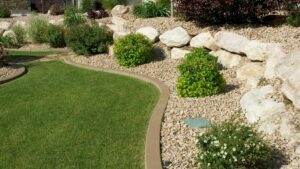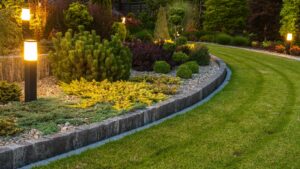In the quest for a greener planet, sustainable landscaping has emerged as a powerful ally. It’s not just about creating a visually pleasing outdoor space; it’s about designing a landscape that works with nature, not against it. From rain gardens that help manage stormwater to native plants that attract local wildlife, sustainability in landscaping offers a world of possibilities.
Sustainable Landscaping Ideas
 Sustainable landscaping, with its emphasis on nature-friendly designs, serves an important role in fostering a healthier environment. It satisfies three key objectives: conservation of water and soil, reduction of waste and pollutants, and promotion of biodiversity.
Sustainable landscaping, with its emphasis on nature-friendly designs, serves an important role in fostering a healthier environment. It satisfies three key objectives: conservation of water and soil, reduction of waste and pollutants, and promotion of biodiversity.
Water and soil conservation, integral components of sustainable landscaping, aid in combating water scarcity and soil erosion. Native plants, often a part of these designs, require less water and support soil health. The use of permeable materials, such as gravel or permeable pavers, allows rainwater to seep into the ground, refilling local water tables instead of causing runoff.
With focus on waste reduction, sustainable landscaping encourages composting and mulching, converting organic waste into nutrient-rich soil. It minimizes the need for chemical fertilizers, reducing the amount of harmful pollutants entering our water systems.
Lastly, by promoting biodiversity, sustainable landscaping creates a habitat for local flora and fauna. Planting various species encourages a richer ecosystem, providing shelter and food sources for local wildlife. This integrates our outdoor spaces with the surrounding natural environment, fostering survival and growth of diverse species.
Exploring Sustainable Landscaping Ideas
 Delving into sustainable landscaping, it’s crucial to highlight rain gardens, drought-tolerant plants, and green walls as key ideas. First on the list, rain gardens. They collect and filter stormwater, reducing pollutants entering bodies of water in the community. These gardens, often adorned with native wildflowers and grasses, add aesthetic value too. Drought-tolerant plants present another idea. These plants, such as Lavender or Ecotopes, require little water, combating water scarcity effectively. Lastly, green walls can play a pivotal role. Acting as a natural air filter, they enhance air quality, health, and well-being. Velocity, immense in these ideas, shows that sustainable landscaping isn’t just beneficial to the environment, but also aesthetically pleasing and useful in enhancing personal wellness. By revealing these distinctive ideas, an individual gains a sturdy platform to make their landscape not only sustainable but thriving and vibrant.
Delving into sustainable landscaping, it’s crucial to highlight rain gardens, drought-tolerant plants, and green walls as key ideas. First on the list, rain gardens. They collect and filter stormwater, reducing pollutants entering bodies of water in the community. These gardens, often adorned with native wildflowers and grasses, add aesthetic value too. Drought-tolerant plants present another idea. These plants, such as Lavender or Ecotopes, require little water, combating water scarcity effectively. Lastly, green walls can play a pivotal role. Acting as a natural air filter, they enhance air quality, health, and well-being. Velocity, immense in these ideas, shows that sustainable landscaping isn’t just beneficial to the environment, but also aesthetically pleasing and useful in enhancing personal wellness. By revealing these distinctive ideas, an individual gains a sturdy platform to make their landscape not only sustainable but thriving and vibrant.
Maintaining a Sustainable Landscape
Caring for plants is crucial. Native species thrive with minimal assistance due to their adaptation to local conditions. However, periodic pruning of unwanted branches improves growth and aesthetics.
Water is vital, yet it’s a scarce resource. Efficiency in water use is indispensable. Rainwater harvesting can play its part in making landscapes more self-sustaining, by collecting rainwater for irrigation, saving gallons of municipal water every year.
Waste minimization is also a pillar of sustainable landscape maintenance. Composting green waste instead of throwing it away ensures a healthy recycling loop. Organic compost can enrich soil quality, promoting plant growth and reducing the need for synthetic fertilizers.
The maintenance of a sustainable landscape may seem intensive, but the long-term environmental benefits are worth the investment. Remember that every step taken towards a more sustainable landscape contributes to a healthier planet.
Case Studies of Successful Sustainable Landscapes
 With the right approach, anyone can transform their outdoor spaces into thriving, eco-friendly landscapes. The benefits are clear: stormwater management, biodiversity support, and resource conservation. It’s all about choosing native plants, composting, and smart water use. Rain gardens and green walls aren’t just trends – they’re key players in sustainable landscaping.
With the right approach, anyone can transform their outdoor spaces into thriving, eco-friendly landscapes. The benefits are clear: stormwater management, biodiversity support, and resource conservation. It’s all about choosing native plants, composting, and smart water use. Rain gardens and green walls aren’t just trends – they’re key players in sustainable landscaping.
Maintaining these landscapes isn’t just about aesthetics. It’s a commitment to the environment. Efficient water use, rainwater harvesting, and waste minimization are key. These practices ensure the longevity of your green space and help our planet in the long run.
The journey towards sustainable landscaping might seem daunting, but it’s a step worth taking. Let’s embrace these practices and work together to create a greener planet. After all, every small step towards sustainability is a giant leap for mankind.

